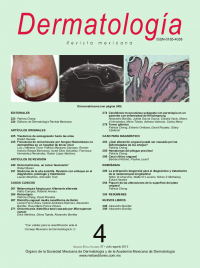Resumen
El onicomatricoma, llamado también tumor en penacho filamentoso de la matriz de la uña, con forma de embudo y onicomatrixoma, se distingue por cuatro signos clínicos que fundamentan la sospecha: coloración amarilla de ancho variable a lo largo de la placa de la uña, crestas más prominentes en la porción afectada, tendencia a sobrecurvatura transversal y mayor engrosamiento, y un tumor que emerge a la avulsión de la uña, en la región de la matriz, con apariencia de embudo y digitaciones filamentosas. Se ha realizado el análisis genómico de los pacientes en un intento de aclarar su aparición. La prueba genética del onicomatricoma mostró 34 alteraciones; la mayor parte de las pérdidas genéticas se encontraron en el cromosoma 11. La hibridización genómica comparativa basada en arreglo reveló la supresión de 11p15.4, que alberga a STIM-1; de 11q14.2 (RP-11 292E14), que alberga al gen catepsina C; de 11q14 (RP11-281F10-RP11-265F24) y de 11q21 (RP11-203F8 y RP11-183A22). Los autores de este trabajo consideran que es un acercamiento inicial al estudio del genoma completo de este tumor. Deben realizarse investigaciones que incluyan más casos para determinar la posibilidad de padecer onicomatricoma. Palabras clave: onicomatrixoma, onicomatricoma, tumor en penacho filamentoso, análisis genómico.
Palabras clave: onicomatrixoma, onicomatricoma, tumor en penacho filamentoso, análisis genómico
Abstract
Onychomatricoma, also called filamentous tufted tumor in the matrix of funnel-shaped nail and onychomatrixoma, is characterized by four suspected clinical signs: A yellow color along the length of the nail plate, wide variable most prominent peaks in the affected portion of the nail that in a normal nail of the same patient, a tendency to over transverse curvature of the affected nail, thickened becomes more pronounced when the yellow color is more extensive and a tumor that emerges the avulsion of the nail, in the region of the matrix with the appearance of a funnel-shaped, with filamentous fingerings. Was performed genomic analysis of patients in an attempt to clarify its development. Genetic testing of the onychomatricoma showed 34 genetic alterations, and most were genetic losses on chromosome 11. Hybridization array-based comparative genomic deletion showed 11p15.4, home to STIM-1, 11q14.2 (RP-11-292E14), which houses the cathepsin C gene, 11q14 (RP11-281F10, RP11-265F24) and 11q21 (RP11-203F8 and 11RP-183A22), the authors of this paper believe that is an initial approach to a genome-wide study of this tumor. Studies should be conducted with more cases to identify possible candidates for the development of onychomatricoma. Key words: onychomatrixoma, onychomatricoma, filamentous tufted tumor, genomic analysis.
Keywords: onychomatricoma, onychomatrixoma, genomic analysis, filamentous tufted tumor

